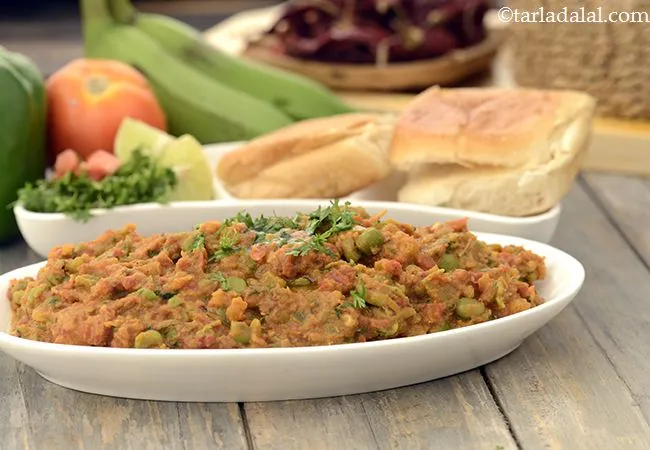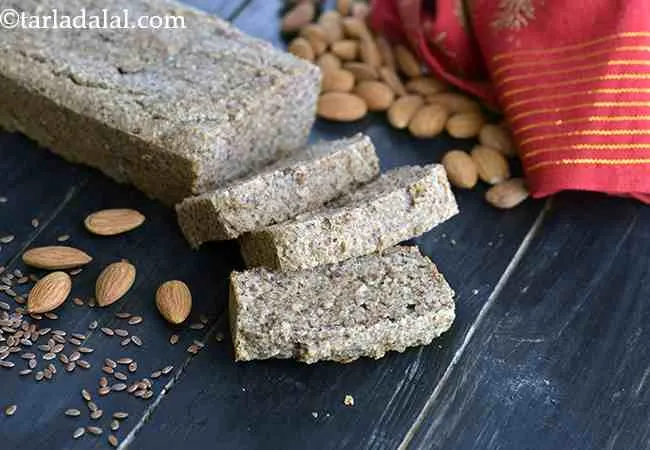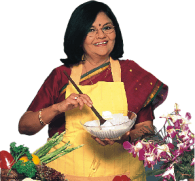Calories in Homemade Pav Bhaji Recipe (How To Make Pav Bhaji At Home)
This calorie page has been viewed 147518 times

How many calories does one serving of Pav Bhaji have?
One serving of Pav Bhaji gives 400 calories. Out of which carbohydrates comprise 232 calories, proteins account for 38 calories and remaining calories come from fat which is 131 calories. One serving of Pav Bhaji provides about 20 percent of the total daily calorie requirement of a standard adult diet of 2,000 calories.
Pav Bhaji recipe serves 5.
400 calories for 1 serving of Pav Bhaji, Cholesterol 42 mg, Made from pav, butter, potatoes, cauliflower, green peeas, carrots, onions, capsicum and tomatoes. Carbohydrates 57.9g, Protein 9.4g, Fat 14.5g. Find how much fibre, iron, calcium, zinc, magnesium, phosphorus, sodium, potassium.
Click here to view. Pav Bhaji recipe. There is nothing healthier than making your homemade pav bhaji versus opting for pav bhaji from the street. While i do love mumbai roadside pav bhaji, i still think you should make your pav bhaji at home.
In this homemade pav bhaji recipe, we have first pressure cooked the vegetables (cauliflower, green peas and carrots), that go into the pav bhaji. Then in a separate deep non stick pan cooked the chilli garlic paste, sauted the onions, capsicum and tomatoes. Added the kashmiri red chillies, pav bhaji masala and cooked with some water. Finally we add the potatoes and pressure cooked vegetables and cooked the mumbai pav bhaji made at home.
Why make mumbai pav bhaji made at home? 1. Street vendors tend to use inferior quality vegetables which are not even cleaned properly. At home, we have the option to use the best quality of everything. 2. Water used to clean vegetables is not filtered by street vendors. 3. Everything is cooked in the open which leads to all kinds of infestation of the food despite it being hot. 4. The butter used is believed to be half margarine and half butter to cut costs and will lead to heart issues.
We make homemade pav bhaji as a one meal dinner. Traditionally pav bhaji is served with yummy ladi pav which is made of plain flour. We suggest you try and use homemade multigrain bread to have with your homemade pav bhaji.
homemade pav bhaji is truly an innovation that arose out of the necessity of providing a nice hot meal in a hurry and one that tickles the taste buds. When I am lazy to cook on an entire meal for my family, pav bhaji in one of the first few dishes which comes to mind. It is easy to cook and also filling.
Aside from pav bhaji, we have other variations like jain pav bhaji, khada pav bhaji, pressure cooker pav bhaji and pav bhaji made with doodhi.
 Jain Pav Bhaji (using Raw Bananas)
Jain Pav Bhaji (using Raw Bananas)
Is Pav Bhaji healthy?
No, pav bhaji is not healthy, but you can make modifications to the recipe and yet enjoy it. Made from pav, butter, potatoes, cauliflower, green peas, carrots, onions, capsicum and tomatoes.
Let's understand the Ingredients.
What's good.
1. Green Peas : Green peas are good for weight loss, good source of vegetarian protein, has insoluble fibre to relieve constipation. Legumes like green peas, cow peas, mung, chick peas and kidney beans have a cholesterol lowering effect. Green Peas are rich in Vitamin K which aids in bone metabolism. Is green peas good for diabetics and see full benefits of green peas.
2. Tomatoes : Tomatoes are extremely rich source of Lycopene. Tomatoes are a powerful antioxidant, super rich in Vitamin C, good for heart. Tomatoes are a Pregnant women's friend and are rich in Folate or Folic Acid which helps your body to produce and maintain new cells, especially red blood cells. Read about 13 amazing benefits of tomatoes.
3. Cauliflower : Cauliflower is extremely low in carbs and therefore does not raise blood glucose levels. One cup Cauliflower provides you 100% off your daily recommended allowance of Vitamin C. Rich in Antioxidant. Being rich in Indoles, Cauliflower and other Cruciferous Vegetables like broccoli, kale, radish, brussel sprouts, red cabbage) maintain Estrogen balances which is crucial for women. Read here for detailed benefits of cauliflower.
4. Carrots : Carrots have the nutrient Beta Carotene which is a form of Vitamin A, helps prevent deterioration of the eye as one gets older and prevents night blindness. Carrot is great for the eyes.They relieve constipation, lower blood pressure, have fibre and lower cholesterol. Read the 11 super benefiits of carrots and why to include in your daily diet.
What's bad.
1. Plain flour used to make Pav : This recipe uses plain flour or maida which is refined carb not suitable for healthy lifestyle. Maida consumption in any food should be totally avoided or just a little bit of usage as any consumption of this will cause a larger spike in blood levels which is not good for diabetics, heart patients. Read is maida good for you to understand fully.
2. Potatoes (Aloo) : Potatoes being high in simple carbohydrates will lead to weight gain and are not good for people with diabetes, heart problem and obesity. Potatoes are recommended for malnourished children and people with low weight. See full details on why potatoes are bad for you.
How do you make this pav bhaji recipe healthy for diabetics, cardiac and weight loss?
Well, you need to make a lot of changes. Drop the bread or pav. Replace with a fibre rich almond bread made without eggs or ragi roti. Sorry, say bye to the traditional bread as there is only plain flour in it. With the bread goes the butter you apply on the bread. So now we are far healthier.

Almond Bread, Homemade Almond Bread Without Eggs
The next step is to drop the potatoes as they are not healthy as explained earlier. If you need to put in weight, then keep the potatoes. You can replace the potatoes with doodhi or try the recipe from pav bhaji made with doodhi. But remember no pav.
8 Pointers to get healthy on a Indian diet
1. Eat healthy and say yes to good home cooked food. Prefer whole grains like oatmeal, quinoa, buckwheat, barley and healthy flours like bajra flour, jowar flour, quinoa flour, wheat flour etc. rather than refined ones like maida. Have healthy Indian fats like ghee, coconut, coconut oil in your diet.
2. Opt out of junk food, packaged food, deep fried foods. Prefer steamed snacks and other non-fried snacks. Check out some Healthy Indian Snacks. Remember to eat small frequent meals through the day as that will keep you always full and prevent your blood sugar from dropping. By starving your body through some diet, will not help you one bit. In fact, dieting will make you binge on 2 to 3 meals which is not good.
3. Have 4 to 5 servings of vegetables and 2 to 3 servings of fruit is a must. Follow the logic of a vegetable in each main meal of the day and a fruit in-between meals. Check out a few Healthy Indian Soups and Healthy Indian Salads recipes using this food group.
4. Cut down on sugar and salt in your diet and pick honey ( very small amounts) or dates to sweeten your food. Slowly cut the sugar habit as this is not going to happen over night. Sugar is also called white poison. It is a simple carbohydrate with zero nutritional value. On intake, sugar will cause inflammation of the body which will last for many hours. It will spike your blood sugar level and shut down the fat burning process. This also causes high blood sugar levels in your body. The development of prediabetes comes from uncontrolled eating sugar and refined food products for many years and the classic symptom is if you have excess belly fat. This leads to diabetes and further onwards to heart attack, high blood pressure, strokes, impotence and kidney damage.
Salt and blood pressure. Apart from stress and obesity, one of the main reasons for high blood pressure is excessive sodium and salt intake. Most people find it difficult to limit the amount of salt in their cooking, thinking it will affect the taste of their favourite dishes.
This is not true. Bajra and jowar are rich in potassium and critical for those with High Blood Pressure as it lessens the impact of sodium. Eating more Potassium Rich Foods will remove more sodium from your body through urine. So include the basic bajra roti and jowar roti in your daily diet to have with Lower Blood Pressure Subzis Recipes.
5. Befriend a few healthy seeds and nuts like chia seeds, flax seeds, sesame seeds, walnuts and almonds.
6. Sprouts are called ‘living food’. They are high is most nutrients and easy to digest as well. Let them feature in your meals at least thrice a week. Also Read : All Benefits about Sprouts.
7. Exercise 45 minutes every day. No excuse. You can walk fast, run, do weights, play your favourite sport or go to the gym.
8. Sleep early and get up early. Get your body into rhythm and it will function best. Sleep helps your body to recover.
Pav Bhaji is high in
1. Vitamin C : Vitamin C is a great defence against coughs and colds.
2. Phosphorous : Phosphorous works closely with calcium to build bones.
3. Vitamin B1 : Vitamin B1 protects nerves, helps in carbohydrate metabolism, prevents heart diseases and helps produce red blood cells.
4. Vitamin A : Vitamin A is crucial for healthy vision, cell growth and healthy skin.
Note : a recipe is deemed high in a Vitamin or mineral if it meets 20% and above the recommended daily allowance based on a 2,000 calorie diet.
How to burn 400 calories that come from one serving of Pav Bhaji?
Walking (6 kmph) = 2 hrs
Running (11 kmph) = 40 mins
Cycling (30 kmph) = 53 mins
Swimming (2 kmph) = 1 hr 9 mins
Note: These values are approximate and calorie burning differs in each individual.
| Value serving | % Daily Values | |
| Energy | 400 kcal | 20% |
| Protein | 9.4 g | 16% |
| Carbohydrates | 57.9 g | 21% |
| Fiber | 4.54 g | 15% |
| Fat | 14.53 g | 24% |
| Cholesterol | 42.0 mg | 14% |
| VITAMINS | ||
| Vitamin A | 1100.7 mcg | 110% |
| Vitamin B1 (Thiamine) | 0.2 mg | 16% |
| Vitamin B2 (Riboflavin) | 0.1 mg | 3% |
| Vitamin B3 (Niacin) | 1.5 mg | 11% |
| Vitamin C | 54.4 mg | 68% |
| Vitamin E | 0.5 mg | 7% |
| Folic Acid (Vitamin B9) | 38.6 mcg | 13% |
| MINERALS | ||
| Calcium | 70.2 mg | 7% |
| Iron | 2.2 mg | 12% |
| Magnesium | 31.3 mg | 7% |
| Phosphorus | 156.8 mg | 16% |
| Sodium | 170.5 mg | 9% |
| Potassium | 255.9 mg | 7% |
| Zinc | 0.4 mg | 3% |
Percent Daily Values are based on a 2000 calorie diet. Your daily values may be higher or lower depending on your calorie needs.

Click here to view homemade pav bhaji
Calories in other related recipes















